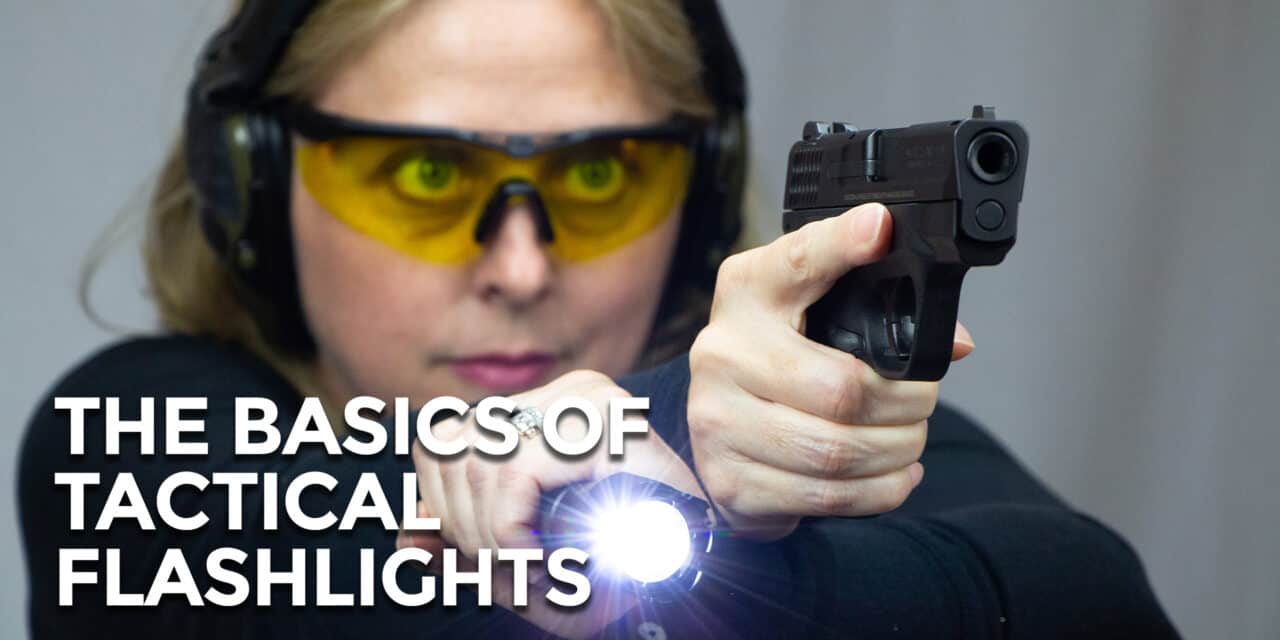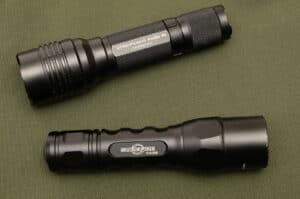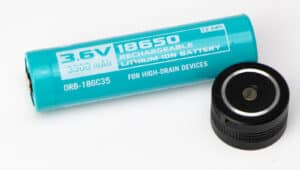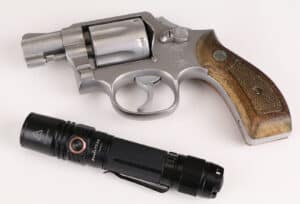Introduction to Tactical Flashlights for Self Defense
It is said that the ancient Greek philosopher Diogenes carried a lamp through the marketplace to help him find an honest man. How ironic it is then that the modern tactical flashlight marketer often seems to be the least honest member of the self-defense community.
Whether you search online or in the local shopping center, you can be overwhelmed by the sheer number of handheld lights that make fantastical claims. Shops sell many of them as “tactical flashlights” suitable for law enforcement and military use.
Let me be clear: many of the flashlights sold in Walmart and on Amazon are not appropriate for self-defense, regardless of their claims.
In this article, I’ll give you some basic information on how to compare flashlights and a few tips on what to look for in a true tactical flashlight.
My Flashlight Requirements
Flashlights are a hobby for some people, but to me they are a tool. In the context of this article, the handheld light is a tool that is designed to help you identify and address a potentially lethal threat.
I’m talking about serious business. Deadly serious.
My parameters for selecting a self-defense flashlight are both simple and inflexible. I expect the light to work as advertised in harsh conditions. A tactical light should be able to withstand a drop onto a hard surface, be water-resistant, and have functions that make sense for its intended purpose.
If a light is likely to fail because I dropped it onto the sidewalk, it may not be durable enough to provide illumination in a violent encounter. Likewise, a light shouldn’t fail because I traveled through a rainstorm.
If a company states the flashlight will provide a certain level of illumination for a specified period of time, I expect it to do that. Likewise, the controls must not hinder my ability to use it in a true tactical context.
After testing more than 100 flashlights during the past seven years, I’ve discovered that there are a few companies you can generally trust. Unfortunately, there are few companies that manufacture flashlights unworthy of any trust.
Marketing and Specifications
Wouldn’t it be nice if there was a standard method of testing tactical flashlights and reporting the data so that consumers could make an informed decision?
There is.
More than 10 years ago, the first set of voluntary flashlight testing specifications were released as part of the FL1 Standard. In 2016, they updated that FL1 Standard.
The FL1 Standard allows a company to have its lights tested in a rigorous process and to report that information in a uniform way so that a buyer can compare lights from two different companies and make an informed decision. Unfortunately, it’s not a perfect process, and the standard can be gamed by unscrupulous companies. Further, the FL1 Standard is completely voluntary, meaning a company doesn’t have to adhere to it but may present information in a deceptive way to lead you to believe it has been. Nevertheless, the FL1 standard is a good place to start when comparing flashlights. It is where I begin my research and is a good place for you to look as well.
What To Look For
The packaging of all flashlights adhering to the FL1 standard should contain information on up to six different categories:
- beam distance
- peak beam intensity
- run time
- light output
- impact resistance
- water resistance or submersible depth
There is a great deal of testing that goes into each category when a company complies with the FL1 Standard. I want to talk about two specifications that many consumers confuse because of marketing tactics: peak beam intensity and light output.
What is Peak Beam Intensity?
Peak beam intensity is the brightness of the center portion of the flashlight’s beam. We measure this in candela. The higher the candela rating, the tighter the beam when the total light output (lumens) remains the same.
What is Light Output?
Light output is the total amount of light a torch prouces, regardless of focus or direction. A bare lightbulb would have the same total output as the same bulb mounted with a reflector producing a defined directional beam. Output is measured in lumens.
Lumens and candela are not directly comparable. In other words, if one flashlight only lists 30,000 candela and another says 600 lumens, you have no way of determining which gives you more light output or how tight a beam it projects.
Run time is another area of confusion. This is how long the tactical flashlight will continue to emit light with a single set of batteries.
It is important to note that under the FL1 Standard, run time is not a measurement of how long the flashlight will emit its rated light output. Rather, it is the period of time from the rated (initial) light output until the light emission drops to a mere 10% of the rated output. A manufacturer could make a flashlight that outputs at 100% for 5 minutes and then 3 hours and 55 minutes at 15% output to achieve a runtime of 4 hours.
If a manufacturer does not provide a run time graph that plots output and time, you don’t have any idea of what to expect based on the run time number alone.
A manufacturer may not display specifications for all of the categories on flashlight packaging. A manufacturer may also display additional information.
The following are examples of approved FL1 iconography.
Unscrupulous manufacturers may use packaging that appears to be very similar to the FL1 Standard icons. This gives the product the appearance of complying with the standard when no such testing actually took place. This marketing creates confusion and is a disservice to you.
Power Source
Three energy sources typically power modern handheld lights:
- CR123A batteries – a 3-volt lithium cell
- 18650 cells – a 3.6 to 3.7-volt lithium-ion rechargeable battery stick
- Conventional alkaline batteries – 1.5-volt cells such as AA or D batteries
About CR123A Batteries
All three of these energy sources are good, but best for different applications. CR123A batteries can provide the brightest light. Two cells in series can provide the highest voltage in a compact package. Additionally, since CR123A batteries use a lithium chemistry, they hold a charge for a long period of time. This applies when you store them or just don’t turn them on frequently.
Conventional Alkaline Batteries
You can easily find vonventional battery types, like AA batteries. They are typically pretty inexpensive. I find this battery type works best in a frequently used light where maximum output isn’t a requirement. Additionally, both AA and AAA batteries are thinner than a CR123A making them ideal for tiny backup lights.
18650 Cells for Power
Many people like flashlights powered by 18650 cells. You can use these rechargeable batteries many times before you’ll need a replacement. In typical circumstances, they can provide a much longer run time and brighter light than conventional cells. However, the 18650 is roughly the length of two CR123A batteries stacked on end. This means the CR123A has the potential of providing a brighter light while the 18650 will often provide a longer run time.
Some manufacturers offer tactical flashlights that will operate on both CR123A batteries and 18650 batteries. With these lights, be careful when examining specifications. You need to ensure you are comparing output and run time from the same battery type.
You should also be aware that there are rechargeable versions of the CR123A and conventional batteries. Their use is fairly straightforward but beyond the scope of this article. I recommend only purchasing high-quality, name-brand rechargeables to use in a self-defense flashlight.
I prefer CR123A batteries for a tactical flashlight that I exclusively carry for self-defense. If I plan to use the flashlight for a variety of things including self-defense, a light that uses the rechargeable 18650 batteries makes more sense to me.
Tactical Flashlight Controls & Modes
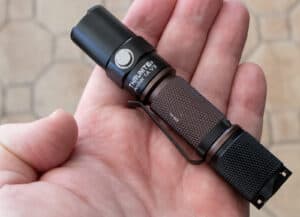 Flashlights have a variety of controls and modes that can be incorporated in the design process. Long gone are the “dumb” analog flashlights of my youth that were nothing more than a bulb, some wire, and a sliding switch to complete the circuit.
Flashlights have a variety of controls and modes that can be incorporated in the design process. Long gone are the “dumb” analog flashlights of my youth that were nothing more than a bulb, some wire, and a sliding switch to complete the circuit.
Today’s flashlights often have multi-function switches and microprocessor-controlled output. A single flashlight may have a variety of light output levels plus lighting effects like strobe mode and SOS signaling.
For the average citizen, I recommend a single-mode tactical flashlight that offers only full brightness or off. Some of the other modes can be useful in limited capacities. However, if you don’t train regularly with the light and know the circumstances in which to use it, you may find it more of a distraction than a genuine help.
With a single output mode, I recommend a switch that allows for a momentary on when the switch is partially depressed and a constant on when the switch is “clicked” on. I’ve found this type of light is the easiest to learn and use under stress.
So, I can just buy that tactical light at Walmart, right?
I’ve had a lot of people tell me that the rando-brand flashlight in the Walmart or Home Depot check-out lane is “good enough” for concealed carry. Maybe it is, maybe it isn’t.
In my testing, I’ve found that a lot of off-brand flashlights fail when dropped onto a hard surface, don’t produce nearly as much light as they claim, and frequently have controls that impede easy use in a dangerous encounter.
The realities of a violent attack suggest that you don’t get to choose the time or location. You may be surprised and the fight may go to the ground. There could be several attackers or just one. A vicious assault could include an attacker stabbing or shooting you, or even ripping one of your ears off in the struggle. As a police officer, I saw much of a man’s face removed, including his nose, by a man who stomped on his head after the victim was knocked to the ground.
Violence is brutal and not like the movies.
With all of these possibilities, I like to remove as many variables from the equation as possible. That means I select reliable handguns, quality knives, and dependable flashlights to carry. There’s a good chance I won’t have time to fumble with a flashlight’s multiple control modes. If I drop it, I don’t want the scene to go dark because a cheap solder connection failed.
Every tactical flashlight is different and has its own unique features that can make it more suitable for you than for me. However, through my extensive testing, I have found that Streamlight, SureFire, and Elzetta tend to make reliable lights. These brands will take a beating and survive long term use. Yes, they are more expensive than a no-name light at Walmart, but your life is worth the extra money.
Final Thoughts on Tactical Flashlights
Like any other defensive tool, a quality tactical flashlight deserves reasoned consideration. The cheapest one you can find might be good for the truck’s glove box, but it will not necessarily be a good match for the specialized needs of personal protection.
We’ll talk about lumens and candela in much more detail in a few weeks.
Take your time when seeking out a flashlight and make sure you are getting exactly what you need. Much like the selection of a firearm or training class, the importance of a good flashlight cannot be overstated.

